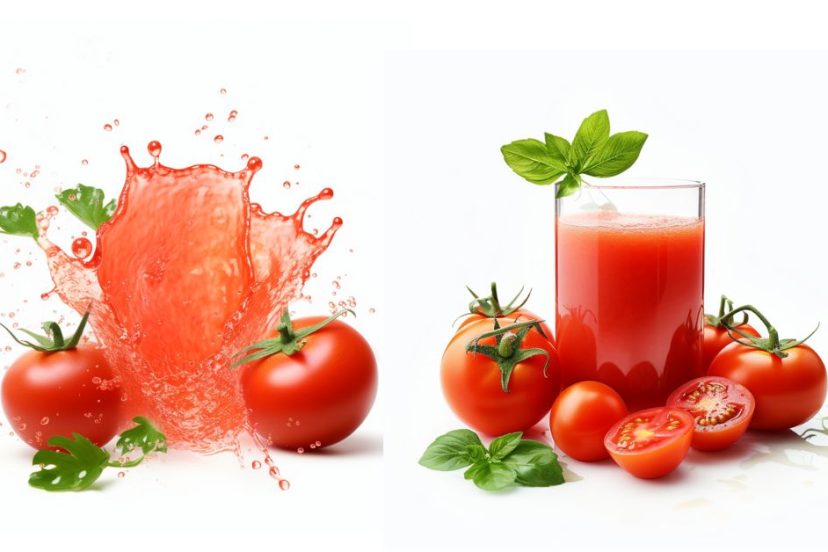How to Make Tomato Juice: A Delicious and Nutritious Addition to Your Diet
Juicing has become increasingly popular as a way to boost one’s health and incorporate more fruits and vegetables into daily routines. As an enthusiast in the world of juicing, I believe that tomato juice is an excellent choice for those looking to enjoy a refreshing and nutritious beverage. In this article, I will guide you through the process of making tomato juice from scratch, providing helpful suggestions and reasons for each step. Let’s dive in and discover how to make tomato juice that’s both delicious and beneficial for your well-being.
Introduction
Tomatoes are not only a staple ingredient in many culinary dishes but are also packed with essential nutrients that offer numerous health benefits. By juicing tomatoes, you can easily harness these benefits and enjoy a glass of fresh, homemade tomato juice. In the following sections, I will share the steps to create tomato juice, starting from selecting the right tomatoes to incorporating it into your diet.
The Benefits of Tomato Juice
Before we delve into the juicing process, let’s explore the reasons why it’s is a fantastic addition to your diet.
Rich in Antioxidants
Tomatoes are a rich source of antioxidants, including lycopene, beta-carotene, and vitamin C. These antioxidants help protect your body against harmful free radicals and oxidative stress, reducing the risk of chronic diseases.
Supports Heart Health
It contains nutrients like potassium, folate, and vitamin B6, which are essential for maintaining heart health. Regular consumption of tomato juice has been linked to lower cholesterol levels and reduced risk of cardiovascular diseases.
Boosts Immune System
Loaded with vitamin C, tomato juice helps strengthen your immune system, aiding in fighting off infections and illnesses. It also contains natural compounds that have antimicrobial properties, supporting overall immune function.
Promotes Digestive Health
It’s is a great source of fiber, which aids in digestion and promotes a healthy digestive system. It can help regulate bowel movements and prevent constipation, ensuring proper nutrient absorption.
Selecting the Right Tomatoes
To make delicious tomato juice, it’s important to choose the right tomatoes. Here are some tips for selecting the best ones:
Fresh and Ripe Tomatoes
Fresh and ripe tomatoes are key to achieving the best flavor and nutritional value in your juice. Look for tomatoes that are plump, firm, and have a vibrant color. Avoid tomatoes that are overly soft or have blemishes.
Organic and Locally Sourced
Whenever possible, opt for organic tomatoes to minimize exposure to pesticides and other harmful chemicals. Additionally, locally sourced tomatoes tend to be fresher and more flavorful.
Different Tomato Varieties
Experiment with different tomato varieties to find your preferred taste. Common varieties used for juicing include Roma tomatoes, beefsteak tomatoes, and heirloom tomatoes. Each variety has its own unique flavor profile.
Preparing Tomatoes for Juicing
Once you’ve selected your tomatoes, it’s time to prepare them for juicing. Follow these steps:
Washing and Cleaning
Thoroughly wash the tomatoes under cool running water to remove any dirt or debris. This step is essential, especially if you’re using tomatoes from your garden or a local farm.
Removing the Stem and Seeds
Using a sharp knife, carefully remove the stem area of each tomato. You can also cut out the tough part where the stem was attached. If you prefer a pulp-free juice, scoop out the seeds as well.
Cutting into Chunks
Cut the tomatoes into smaller, manageable chunks. This will make it easier for your juicing method of choice and ensure a smoother consistency.
Juicing Techniques
There are several techniques you can use to extract the juice from tomatoes. Let’s explore three popular methods:
Using a Blender
A blender is a common household appliance that can be used to make various juices. Simply add the tomato chunks to the blender and blend until smooth. To achieve a smoother texture, you can strain the blended mixture through a fine-mesh sieve or cheesecloth.
Using a Juicer Machine
A juicer machine is specifically designed to extract juice from fruits and vegetables. Follow the manufacturer’s instructions for juicing tomatoes using your specific juicer model. This method generally produces a more refined juice with less pulp.
Hand-Pressing Method
For a more rustic approach, you can use your hands to squeeze the juice out of the tomato chunks. Place the tomato chunks in a fine-mesh sieve or cheesecloth, and gently press down to extract the juice. This method may require more effort but can be quite rewarding.
Enhancing the Flavor
While tomato juice is delicious on its own, you can enhance its flavor by adding various ingredients. Here are some suggestions:
Adding Citrus Fruits
Squeeze a fresh lemon or lime into your juice to add a refreshing tang. Citrus fruits complement the natural sweetness of tomatoes and provide an extra burst of vitamin C.
Experimenting with Herbs and Spices
Infuse your tomato juice with additional flavors by experimenting with herbs and spices. Consider adding a pinch of salt, black pepper, basil, or cilantro to create a unique taste profile.
Combining with Other Vegetable Juices
For a more complex flavor, mix tomato juice with other vegetable juices like carrot, celery, or cucumber. This not only diversifies the nutrient content but also adds depth to the overall taste.
Storing and Preserving Tomato Juice
If you have leftover tomato juice or want to prepare a larger batch in advance, it’s important to store and preserve it properly. Consider the following methods:
Refrigeration Method
Store your freshly made tomato juice in an airtight container and place it in the refrigerator. Consume within 2-3 days to ensure optimal freshness and flavor.
Freezing Method
If you want to extend the shelf life, freezing is a viable option. Pour the juice into ice cube trays or freezer-safe containers, leaving some space for expansion. When needed, thaw the juice in the refrigerator and give it a good stir before consuming.
Canning Method
Canning is a popular preservation method that allows you to enjoy homemade tomato juice throughout the year. Follow proper canning procedures and guidelines to ensure safety and prevent spoilage. Consult reliable sources or local canning experts for detailed instructions.
Incorporating Tomato Juice into Your Diet
Now that you have a batch of delicious tomato juice, let’s explore different ways to incorporate it into your diet:
Drinking It Straight
Enjoy a refreshing glass of tomato juice on its own as a standalone beverage. It’s a fantastic way to hydrate your body and reap the numerous health benefits of tomatoes.
Using It in Smoothies
Blend it with other fruits and vegetables to create nutritious and flavorful smoothies. Combine it with ingredients like spinach, apples, and ginger for a vibrant and energizing drink.
Adding to Soups and Sauces
It can serve as a flavorful base for homemade soups and sauces. Use it as a liquid component in tomato-based soups, stews, or pasta sauces for added depth of flavor.
Tomato Juice Recipes
To inspire your juicing journey, here are three simple and delicious tomato juice recipes:
Classic Tomato Juice
Ingredients:
- 4 ripe tomatoes
- 1 lemon, juiced
- Pinch of salt
- Dash of black pepper
Instructions:
- Wash and prepare the tomatoes as mentioned earlier.
- Blend the tomatoes in a blender until smooth.
- Strain the mixture through a fine-mesh sieve or cheesecloth to remove any pulp.
- Add the lemon juice, salt, and black pepper to the strained juice.
- Stir well and serve chilled.
Spicy Tomato Juice
Ingredients:
- 4 ripe tomatoes
- 1 small jalapeño pepper, seeds removed
- 1 lime, juiced
- Pinch of salt
- Dash of cayenne pepper (optional)
Instructions:
- Wash and prepare the tomatoes as mentioned earlier.
- Blend the tomatoes and jalapeño pepper in a blender until smooth.
- Strain the mixture through a fine-mesh sieve or cheesecloth.
- Add the lime juice, salt, and cayenne pepper (if desired) to the strained juice.
- Mix well and serve over ice.
Tomato-Cucumber Juice
Ingredients:
- 2 ripe tomatoes
- 1 cucumber, peeled and chopped
- Handful of fresh basil leaves
- 1 lemon, juiced
- Pinch of salt
Instructions:
- Wash and prepare the tomatoes as mentioned earlier.
- Blend the tomatoes, cucumber, and basil leaves in a blender until smooth.
- Strain the mixture through a fine-mesh sieve or cheesecloth to remove any remaining pulp.
- Add the lemon juice and salt to the strained juice.
- Stir thoroughly and enjoy chilled.
Safety Precautions and Considerations
While tomato juice is generally safe and beneficial, it’s important to keep the following precautions in mind:
Allergies and Sensitivities
Some individuals may have allergies or sensitivities to tomatoes. If you experience any adverse reactions after consuming tomato juice, such as itching, swelling, or difficulty breathing, discontinue its consumption and seek medical advice.
Consulting with a Medical Professional
If you have any underlying health conditions or are on specific medications, it’s always a good idea to consult with a medical professional before making significant changes to your diet, including consuming tomato juice regularly.
Conclusion
Incorporating tomato juice into your diet can be a delightful and nutritious choice. By selecting the right tomatoes, preparing them properly, and experimenting with flavors, you can create delicious homemade tomato juice that suits your taste preferences. Remember to store and preserve the juice correctly, and explore various ways to enjoy it in drinks, soups, and sauces. Embrace the benefits of tomato juice and make it a part of your juicing routine to support your overall health and well-being.
FAQs
Q1: Can I use canned tomatoes to make tomato juice? A: While fresh tomatoes are ideal, you can use canned tomatoes as a substitute. Choose canned tomatoes without added salt or preservatives for the best results.
Q2: Can I juice unripe tomatoes? A: It’s best to use ripe tomatoes for juicing as they are sweeter and more flavorful. Unripe tomatoes may result in a sour or less enjoyable taste.
Q3: Can I store tomato juice at room temperature? A: It is not recommended to store homemade tomato juice at room temperature as it can spoil quickly. Always refrigerate or freeze tomato juice to maintain its freshness.
Q4: Can I mix it with alcohol? A: Tomato juice is a popular ingredient in cocktails like Bloody Mary. However, it’s important to consume alcohol in moderation and consider your personal tolerance and health conditions.
Q5: Can I add sugar to sweeten the tomato juice? A: It naturally contains some sweetness, but if you prefer a sweeter taste, you can add a small amount of natural sweeteners like honey or maple syrup. Remember to keep it in moderation.
Other resources.
- “Tomatoes and Cardiovascular Health,” – This article from the National Center for Biotechnology Information explores the benefits of tomatoes for cardiovascular health, citing several studies that indicate a connection between lycopene (a compound found in tomatoes) and improved heart health.
- “Consumption of Processed Tomato Products Enhances Plasma Lycopene Concentrations in Association with a Reduced Lipoprotein Sensitivity to Oxidative Damage,” – This study, published in The Journal of Nutrition, discusses the benefits of processed tomato products (like tomato juice) in increasing plasma lycopene concentrations, which is linked with a range of health benefits, including a reduced sensitivity to oxidative damage.




